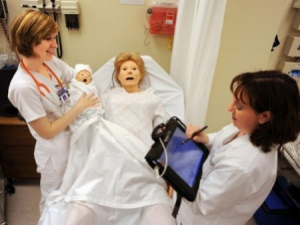Do the Mannequins Really Vomit on You?
on Friday, 13 May 2016.
Healthcare is booming. Mostly because of the boomers. As the largest generational population in US history ages, the impact on all facets of healthcare and medicine is undeniable. History.com points out the by 2030 ONE IN FIVE Americans will be over the age of 65. Today boomers make up more than a quarter of the total US population. The baby boomer generation was the most educated generation in the US up until that point. They got married later, 50% of them got divorced, they made good money and they pushed the boundaries of traditional American households. Outside the house, they made strides in business, politics and medicine. According to Wikipedia (you can’t believe everything you read on the interweb) “baby boomers control over 80% of personal financial assets and more than half of all consumer spending. They buy 77% of all prescription drugs, 61% of over-the-counter drugs, and 80% of all leisure travel.”
You probably understand where this is heading. Boomers are aging…lots of them. They make up almost 30% of the US population. In addition to that, medical technology continues to evolve and directly impacts the average life-expectancy. Diseases and afflictions that would have killed someone 50 years ago...
A significant portion of our population is beyond 50 years old and will be living longer than any generation before them. So it isn’t a surprise when I walk onto a college campus and find out that “the new building” going up is for the School of Nursing, School or Health Professions, School of Health Service…you get the idea. Colleges and Universities across the country are reinforcing, expanding or creating healthcare related tracks. In our FSR backyard, Montclair State University in NJ will be opening its brand new School of Nursing to 100 carefully selected students this coming September.
There are specific technological complexities that have to be considered when upgrading or creating new classrooms and labs for these types of spaces. The buildings will require somewhat “standard” infrastructure for distance learning, lecture capture, collaboration, (etc.) of course. But also (potentially) for life-like mannequins, observation labs, consult spaces, video conferencing, room control, nurse-call tie in and more. The quality of AV must be very high in these environments, as pixilation, latency, and non-seamless switching could result in poor learning and inadequate diagnosis. Similarly, the need for a certain level of HIPAA compliance (mainly in clinical or tele-health setting) may...
